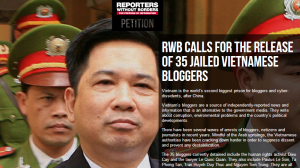Last line of Defence - Tuyến Phòng Thủ Cuối Cùng
Featured
-
Writer jailed in Vietnam to be recognized with international award
-
Trại giam số 6 không cho TNLT Bùi Văn Thuận và người nhà giao tiếp bằng tiếng Mường
-
Hà Nội: Ba người dân xã Đồng Tâm được ra tù trước thời hạn 9 tháng
-
DTD và 9 tổ chức XHDS kêu gọi Mỹ không bán vũ khí cho Bộ Công an Việt Nam
-
Jailed Vietnamese writer honored with international award
-
Khmer Krom group petitions for Vietnam to be removed from UN body
-
City bar association cancels membership of Vietnamese activist lawyers
Recent Comments
-
Height Insoles: Hi, I do believe this is an excellent site. I stumbledupon …
-
http://fishinglovers.net: Appreciate you sharing, great post.Thanks Again. Keep writi…
-
Achilles Pain causes: Every weekend i used to pay a quick visit this site, as i w…
Powered by WordPress • Themify WordPress Themes






January 7, 2015
Why reduced South China Sea tension is possible in 2015
by Nhan Quyen • [Human Rights]
Robert Farley, professor at University of Kentucky’s Patterson School of Diplomacy and International Commerce, believes that the import-oriented trend in the oil industry can affect how rival claimants China and its smaller neighbors such as the Philippines see economic prospects of the key waterway.